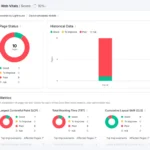
Introduction
The e-commerce landscape is evolving faster than ever — and E-Commerce SEO in 2025 is no longer just about keywords and backlinks.
Today, Google’s algorithms are more intelligent, user expectations are higher, and AI-driven search results are reshaping how customers find and trust online stores. To stay competitive, your e-commerce SEO strategy must go beyond traditional optimization — focusing on structured data, speed, and trust.
Let’s explore what’s changing and how you can prepare your online store for sustainable visibility and conversions in 2025.
Why E-Commerce SEO Still Matters
With over 26 million e-commerce sites globally, standing out organically is harder than ever. Paid ads can drive traffic — but SEO builds long-term authority, lower acquisition costs, and higher trust.
In 2025, Google’s Search Generative Experience (SGE) and AI-powered overviews will heavily influence how users discover products. That means your content and technical structure must help search engines understand your brand, your products, and your credibility.
E-Commerce SEO in 2025 = Technical precision + User experience + Authentic trust.
1. Structured Data: The Foundation of Smarter Search
Structured data (schema markup) helps Google and AI systems understand your website’s content. For e-commerce, it’s not optional — it’s critical.
Why Structured Data Matters
- Makes your products eligible for rich results (price, ratings, stock).
- Improves click-through rates (CTR) with visual enhancements.
- Helps AI systems like Google’s AI Overview accurately interpret your products.
- Boosts trust by connecting data (products, reviews, offers) with recognized entities.
Key Types of Structured Data for E-Commerce
- Product Schema — Include price, description, SKU, reviews, and availability.
- Offer Schema — Highlight discounts, deals, and shipping details.
- Review & AggregateRating Schema — Display average star ratings and review counts.
- Breadcrumb Schema — Help both users and bots navigate your site structure.
- FAQ Schema — Improve voice search and snippet visibility.
2. Speed: The Ultimate Conversion Factor
In 2025, speed is more than a ranking factor — it’s a sales multiplier. Google’s Core Web Vitals update continues to emphasize user experience metrics like:
- LCP (Largest Contentful Paint): How fast your main product image or banner loads.
- CLS (Cumulative Layout Shift): Prevent layout movement during load.
- INP (Interaction to Next Paint): Replaces FID, measuring responsiveness to user actions.
How to Improve E-Commerce Site Speed
- Use a CDN (Content Delivery Network) to serve global traffic faster.
- Optimize images (WebP, AVIF formats) and enable lazy loading.
- Minify JavaScript and CSS to reduce render-blocking elements.
- Enable caching for returning visitors.
- Use server-side rendering (SSR) for dynamic product pages.
💡 Did you know? A one-second delay in page load can reduce conversions by up to 20%.
Fast sites don’t just rank higher — they sell more.
3. Trust: The New Currency of SEO
In an age of AI-generated content and fake stores, trust is your biggest differentiator. Google’s E-E-A-T (Experience, Expertise, Authoritativeness, Trustworthiness) framework is crucial for e-commerce success.
How to Build Trust for SEO
- Use HTTPS and Secure Checkout
- SSL certificates are mandatory — both for SEO and buyer confidence.
- Show Authentic Reviews and Ratings
- Collect verified customer feedback and display it using Review Schema.
- Add Clear Return and Shipping Policies
- Transparency increases conversion rates and reduces bounce rates.
- Highlight Real People Behind the Brand
- Include team photos, About Us pages, and customer support info.
- Leverage Social Proof
- Add UGC (User Generated Content) and verified badges where possible.
When Google sees consistent signals of trust — secure pages, verified reviews, strong branding — it rewards your site with better visibility in AI-driven search results.
4. Mobile Optimization: Where the Conversions Happen
Over 70% of online shoppers now buy through mobile. Google’s mobile-first indexing means your mobile performance directly determines rankings.
Mobile E-Commerce SEO Checklist
- Responsive design that adapts to all screen sizes
- Simplified navigation and minimal pop-ups
- Fast checkout with auto-fill and mobile wallets (Google Pay, Apple Pay)
- AMP (Accelerated Mobile Pages) for key product pages
Fast, mobile-friendly pages are prioritized in Google AI Overview summaries and featured snippets.
5. AI Search Optimization: Preparing for the Future
AI-powered search is changing how consumers discover products. Google’s AI Overviews and tools like Bard and Gemini pull summarized product data directly from web content.
To stay visible:
- Write conversational, question-based product descriptions.
- Include FAQ sections for common queries.
- Use semantic SEO — relate your product pages to broader topics like “best budget wireless headphones” or “eco-friendly fashion trends.”
- Publish supporting blog posts and link internally (e.g., “Best SEO Tools for E-Commerce”).
These help Google’s AI systems understand your brand contextually and recommend your products in generative search results.
6. Monitor, Measure, and Improve
SEO for e-commerce is an ongoing process. Use the right tools to monitor performance:
- Google Search Console: Check for indexing and Core Web Vitals reports.
- PageSpeed Insights: Audit and improve load times.
- Ahrefs / SEMrush: Track backlinks and keyword positions.
- Schema Markup Validator: Verify structured data health.
Regularly update your product pages, optimize descriptions, and ensure consistent structured data — these are the pillars of E-Commerce SEO 2025.
Conclusion
As we move into 2025, E-Commerce SEO is about more than just rankings — it’s about building a search-friendly, trustworthy, and lightning-fast experience that aligns with how AI and real users interact online.
By leveraging structured data, optimizing page speed, and prioritizing trust, you position your store not only to appear in Google’s AI Overviews but to dominate the digital shelf.
In short:
🧩 Structured Data helps you get found.
⚡ Speed keeps users engaged.
🤝 Trust turns visitors into loyal customers.
Start optimizing now — because in 2025, SEO isn’t a checkbox; it’s your competitive edge.
FAQs
1. What’s the biggest SEO change for e-commerce in 2025?
The rise of AI-driven search and Google’s AI Overview is changing how users find products. Structured data and trust signals are now critical ranking factors.
2. How can structured data improve my online store’s visibility?
It helps Google understand your products better, making them eligible for rich results, reviews, and price displays in search results — all of which boost clicks and conversions.
3. Why is page speed so important for SEO and sales?
A slow website frustrates users and increases bounce rates. Faster sites rank higher, convert more customers, and perform better in Core Web Vitals.
4. What are the best tools for e-commerce SEO?
Use tools like Google Search Console, PageSpeed Insights, and Ahrefs. For schema testing, try Google’s Rich Results Test. You can also check out our article on SEO tools for more recommendations.
5. How does trust impact SEO performance?
Google rewards trustworthy sites with higher visibility. Secure checkout, real reviews, transparent policies, and expert content signal reliability to both users and search engines.
Visit our services – SEO services in Kanpur | SEO services in Surat | SEO company in Jaipur | SEO comapany in Lucknow| SEO company in Ameerpet





